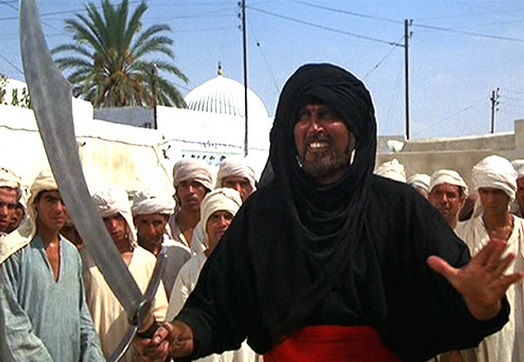  |
 |
 |
 |
|
MahdiWatch.org
|
 |
|
Home | About Me | Links to My Articles | Info on My Books | Contact Me
|
 |
|
Welcome to MahdiWatch.org! NEWSFLASH! COMMENTS LINK
BELOW EACH POST IS ENABLED! FEEL FREE TO BURY ME, PRAISE ME--OR JUST ISSUE A PERSONAL FATWA!
al-Mahdi is "the rightly-guided one" who, according to Islamic Hadiths (traditions),
will come before the end of time to make the entire world Muslim. Over the last 1400 years numerous claimants to the
mantle of the Mahdi have arisen in both Shi`i and Sunni circles. Modern belief in the coming of the Mahdi has
manifested most famously in the 1979 al-`Utaybi uprising of Sa`udi Arabia, and more recently in the ongoing
Mahdist movements (some violent) in Iraq, as well as in the frequently-expressed public prayers of former Iranian
President Ahmadinezhad bidding the Mahdi to return and, in the larger Sunni Islamic world, by claims that Usamah bin Ladin
might be the (occulted) Mahdi. Now in 2014 Mahdism is active in Syria, as the jihadist opposition group Jabhat al-Nusra
claims to be fighting to prepare the way for his coming; and in the new "Islamic State/caliphate" spanning
Syrian and Iraqi territory, as its leadership promotes the upcoming apocalyptic battle with the West at Dabiq, Syria. This site will track such Mahdi-related movements, aspirations, propaganda and beliefs in both Sunni and Shi`i
milieus, as well as other Muslim eschatological yearnings.
For a primer
on Mahdism, see my 2005 article, "What's Worse than Violent Jihadists?," at the History News Network: http://hnn.us/articles/13146.html; for more in-depth info, see the links here to my other writings, including my book on Mahdism.
|
|
|
|
Tuesday, May 28, 2013
Happiness is a Warm....Blade--at least for Qur'anic Literalists
I appeared on the BBC show "Sunday Sequence" (May 26, 2013) discussing the Islamic beheading of British soldier Lee Rigby in London last week. I appeared opposite several British academics, at least one of whom
was Muslim--and all of whom were apologetic regarding Islam. There was much nattering about blaming the attack on "urban
youth counterculture," not Islam; attempts to portray the attacks as "lunatic" and fringe;" and one interlocutor
even stressed the need to "understand the anger" of the perpetrators. As the Orientalist American analyst,
I disagreed on all three points, noting that: beheadings in the name of Islam have been done in many countries, and not just
by allegedly alienated youth; such violence is based on the Qur'an and examples of Muhammad himself--who would thus seem to
have been a fringe lunatic himself; and why in hell do we have to "understand" Muslims who hack and behead a non-Muslim?
Here's the link to " Sunday Sequence." I come on at about 37:40. Also: I was asked to be on because the producer found (and presumably read)
my article " Beheading in the Name of Islam." 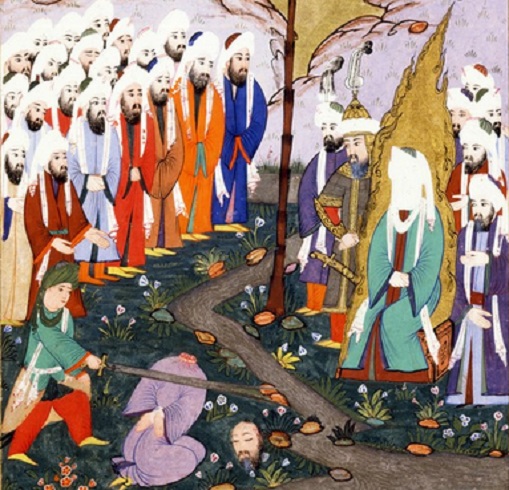 Ali beheading al-Nadr b. al-Harith, a poet who mocked "the prophet." Note
said "prophet" looking on approvingly. Can someone send this art to David Cameron? Ali beheading al-Nadr b. al-Harith, a poet who mocked "the prophet." Note
said "prophet" looking on approvingly. Can someone send this art to David Cameron?
Wednesday, May 15, 2013
Janissaries, Jacqueries and Jihad
Three of my favorites Islamic world topics are the Ottoman Empire, Sufism and—of
course—Mahdism. So when all three are rolled together, as they are in a book chapter by Ahmet Yaşar
Ocak, I must blog on the topic or die; I can do no less! Ocak’s
publication from 2007, which I just recently found, is entitled “Sufi Milieux and Political Authority in Turkish History:
A General Overview (Thirteenth-Seventeenth Centuries),” and found in Paul L. Heck, ed., Sufism and Politics: The
Power of Spirituality (Princeton: Markus Wiener), pp. 165-195. Ocak’s topic
is the love-hate relationship between the Ottoman state and the Sufi (mystical) orders found therein. A
number of Sufi orders—Bektaşis, Naqshbandis, Mawlawis (Mevlevis)—were officially sanctioned and supported
by the sultans; the Bektaşis, in fact, were the official order of the sultan’s shock troops, the yeniçeris or “Janissaries,”
such that many soldiers were members and Bektaşi shaykhs served as military chaplains. On the other
hand, two more antinomian orders—the Qalandaris and Malamatis—were more often at loggerheads with Istanbul.
The Qalandaris were suspect and repressed because they liked to shave their heads, faces and eyebrows; received support
from the Ottomans’ archenemies over in Persia, the Twelver Shi`i Safavids (because of theological similarities between
Qalandari Sufism and Twelver Shi`ism); and, most damningly, because one of their shaykhs once tried to assassinate a sultan.
The Malamatis were more hirsute but had in many ways a bigger problem vis-à-vis Istanbul: their
shaykhs tended to want to proclaim themselves Mahdis; and this is, to put it mildly, problematic from an imperial point of
view—because when someone claimed he was the Mahdi, this “implied that that political power should be vested in
him, rendering the Ottoman government illegitimate and cruel” (Ocak, p. 183). Shaykhs,
or tribal leaders, of other orders also sometimes declared themselves the Mahdi in Ottoman domains. Between 1240 and 1665,
at least nine different Sufi or Sufi-affiliated men led major Mahdist revolts against Ottoman authority:
In 1240,
two Turkmen Wafa`i Sufis:
1) Baba Ilyas-i Khurasani 2)
Baba Ishaq
In 1416, three Qalandari shaykhs:
3) Torlaq Kamal 4)
Borklug Mustafa 5) Badr
al-Din (the last “supported by [Byzantine] Christian feudal lords who had lost their domains to the expanding
Ottomans” (Ocak, p. 187)
In 1511: 6) Shah Qulu (instigated
by Safavids)
1512: 7)
Nur Ali Khalifa
1520: 8)
Shah Wali
1665: 9) Sayyid
Abd Allah (#6-9 are unspecified Sufis who “presented themselves as sahib al-zaman [“Lord
of Time/the Age”] and mahdi al-dawran [“Mahdi of the Period”] (Ocak, pp. 187-88).
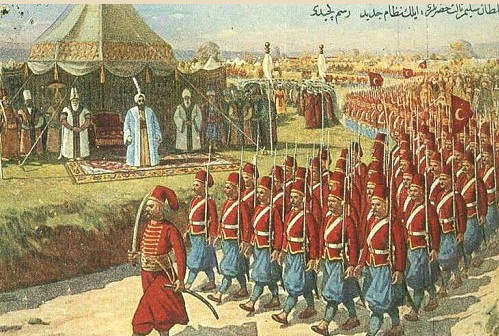
Attack of the Cloned Janissaries. Moustache wax was part of the Ottoman military kit,
no doubt.
Of
course, it is little surprise that Sufi mileux are often the ground for Mahdist movements. I’ve remarked
many times before, on this blog and in published articles, that Sufis are predisposed to charismatic leadership and have a
ready-made organizational structure that lends itself to mass movements, particularly Mahdism. And as Ocak
observes, Ottoman Sufis (at least the official orders) were jihadistic: “[e]specially in wartime they [Sufis] were a
great source of moral support for both sultans and soldiers….They gave speeches encouraging the soldiers in jihad and
offered prayers for victory. At times, the accompanied the sultans on military campaigns, which spurred the soldiers to fight
with greater enthusiasm” (p. 179). This was noted some years ago, too, by that great scholar of Sufism
J. Spencer Trimingtham: “Evliya Çelebi [the renowned Ottoman writer] writes of hundreds of dervishes…who
took part in the final siege of Constantinople” (The Sufi Orders in Islam, p. 240).
One final
bit from Ocak, before I move on to my own analysis: while Western European jacqueries are often adduced
by historians and sociologists as analogous to Mahdist rebellions in Islamic lands, there is at least one major difference:
the latter are not purely socioeconomic or political, but usually infused with Islamic Sufism; and in fact “even once
the movement had been repressed and its followers eliminated, their memory survived among the people as long-enduring legend”
(pp. 184-5).
Observations:
1) Ottoman problems with Sufis and even with self-styled Mahdis did not stop in the 17th century;
North/East African, Anatolian Kurdish and Middle Eastern Arab Sufis fought the Ottomans at various times in from the 18th-20th
centuries, epitomized by the Sufi Muhammad Ahmad of Sudan (d. 1885) whose declared Mahdism was the most succeessful.
And in fact Mahdism even broke out in the Turkish Republic, as late as 1930, in the town of Menemen, as one Mehmet
declared a jihad against the secular state and beheaded a police officer before the Turkish army sent him to the afterlife
(see my book Holiest Wars, pp. 58ff). Note that the Ottoman domains were predominatly Sunni and
that thus mystical Islam was being deployed, for the most part, by and against non-Shi`is.
2) Martial Sufis have lived on to fight another day—today. One prominent
example is in the former Ottoman province of Iraq, where the Naqshbandi Sufis fought against the American occupiers and continue
their jihad against the Shi`i regime in Baghdad as Jaysh Rijal al-Tariqa al-Naqshbandiya. Another is in Somalia, where for several years the pan-Sufi Ahl al-Sunna wa-al-Jama`a has
fought against the al-Qa`ida-linked al-Shabab. In much of the rest of the Islamic world—Tunisia,
Libya, Egypt, Pakistan, Afghanistan—Sufis are under attack, not from governments but from Wahhabi-Salafi Islamic fundamentalists.
3) Sufism, contra many analysts with their
heads firmly buried in secular sands, is quite prevalent and influential in the modern Islamic world. According
to last years’s Pew study, “The World’s Muslims: Unity and Diversity,” some 19% of the Islamic world’s populace belongs to Sufi orders, comprising
over 300 million people. Also, that same study examined Muslim belief in “the Mahdi’s imminent
return” and ascertained that some 42%--over 670 million—of the world’s Muslims hold to it. Based
on that data, the anomaly is not that Sufism ever erupts into Mahdism—but rather that it doesn’t happen far more
often, in the modern world!
4) Note that the collapsing
(under incessant Muslim attacks!) Christian Byzantine Empire was not above aiding and abetting Sufi-fueled Mahdist revolts
against the Ottoman Empire—because the enemy of their enemy was their friend. Perhaps we should
consider incorporating a similar approach into our geopolitics and counter-terrorism strategy.
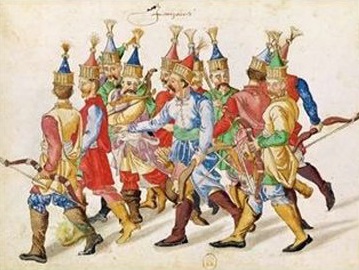
Janissaries, Sufis--or Elves?
Based on the bows, I'd say Sindar from Mirkwood. But you be the judge.
12:40 pm edt
Monday, May 13, 2013
Lojacking the Apocalypse
Yesterday, during the obligatory but decidedly non-liturgical
(and, let’s be frank, non-Biblical) Mother’s Day sermon, I tuned out (please don’t tell my pastor!) and
was re-reading the Petrine epistles—which I’ll be teaching, along with Jude and both letters to the Thessalonians,
during June at my church. Although I’m a Lutheran, I often use the Orthodox Study Bible, where I
found this very interesting and relevant commentary note on II Peter 3:10-12 (which talks about the “day of the Lord”
coming as a “thief in the night” and the passing away of this world): “Christians can actually hasten
the coming of that day. How? Through evangelism…prayer…holy living…and
repentance and obedience.” [Ellipses are where I removed the Biblical citations, lest any of
my secular readers start feeling queasy, oppressed or, God forbid, targeted for conversion.]
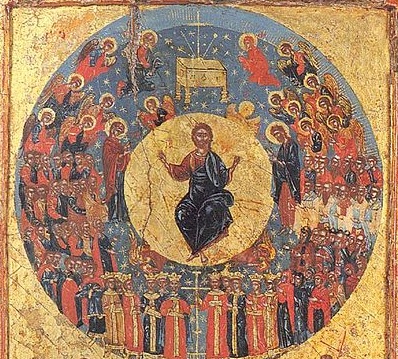
"'Marana tha!' after we nuke our enemies!" No, wait, that's not right....
What a striking contrast with, on one
hand, the much-publicized (and –derided) view of some Evangelical Christians about how to advance Jesus’ return
(usually by rebuilding the Jewish Temple); and, on the other, that of some Muslims (mainly Sunni jihadists), who similarly believe that the coming of the Mahdi can be “hotwired.” This Orthodox Christian view of gently and piously coaxing Christ to return is
a far cry from the “if you build it, He will—nay, must!—come!” importuning of a John Hagee or Hal
Lindsay. And it is thus light-years away from the (thankfully minority—so far) Islamic position that
nuking Tel Aviv or New York will force Allah to send the Mahdi and his tag-team partner `Isa. Actually,
despite mainstream media hyperventilation, the Orthodox Christian stance is the majority Christian one, shared by Catholics,
Lutherans and Anglicans/Episcopalians. (Evangelicals, although numerous and particularly galling to liberals
in the US, comprise a minority of the world’s Christians—although you would be hard-pressed to get them to admit that fact.) Most
interesting (at least to me) is that, based on my research, the Twelver Shi`i view is very similar to this pious pleading one advocated by Orthodox
Christianity, and not at all like the Sunni jihadist one—contra alarmist, and frankly ignorant, screeds about Iran’s apocalyptic aims.
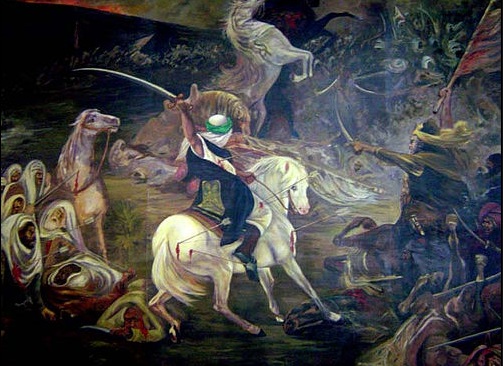
Yes, a whole lotta slaughtering will be done--but AFTER Imam al-Mahdi comes, not before!
11:58 am edt
Tuesday, May 7, 2013
The Mahdi Under African Skies
As a newly-minted fellow at RIMA, "Research on Islam and Muslims in Africa," I recently completed
a brief Q & A on the topic of Mahdism in Africa as part of RIMA's "Ask the Expert" series. Please take a few minutes to check it out, if you're
interested in Mahdism, Islam in Africa, Sufism, and/or jihad! As a companion piece, I suggest reading my History News Network
article "Mahdism (and Sectarianism and Superstition) Rises in the Islamic World" (Aug. 13, 2012), which unpacks the Pew data on just how many Muslims--particularly in Africa--believe in the imminent
coming of the Mahdi.
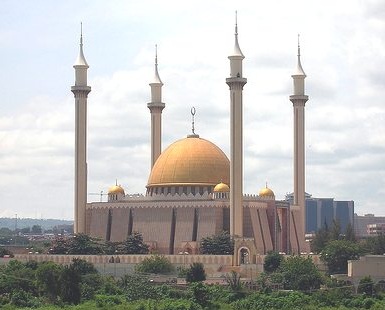
National Mosque, Abuja, Nigeria. Northern Nigeria was once known as the Sokoto Caliphate,
which was created by Usman don Fodio (d. 1817), considered by many Hausa to be the Mahdi.
Saturday, May 4, 2013
The New Pew Study on Islam Gives Me No Satisfaction
The “strategerists” over at zenpundit.com were nice enough last week (May 2, 2013)
to feature my guest-blog breaking down the newest Pew study of Muslim attitudes. My five take-aways:
1) support for shari`a is widespread, and belies the “Islam has been hijacked by a few extremists” trope;
2) Afghanistan is a lost cause, and the sooner we get out, the better; 3) certain areas of the umma (Southeastern
Europe, sub-Saharan Africa) are more tolerant—or at least less ruthless—toward non-Muslims than others (the Middle
East proper); 4) Malaysia may very well be the next breeding ground of Islamic terrorists; and 5) try as they might, the media’s
attempts (and yes, this includes Fox News) to equate Evangelical Christians with Muslims in terms of missing the modernity
train simply fall flat. Go
check out the whole piece.
And yes, as a matter of fact--I'm on a Rolling Stones kick lately. Blame it on my purchase
of their newest greatest hits collection, GRRR!
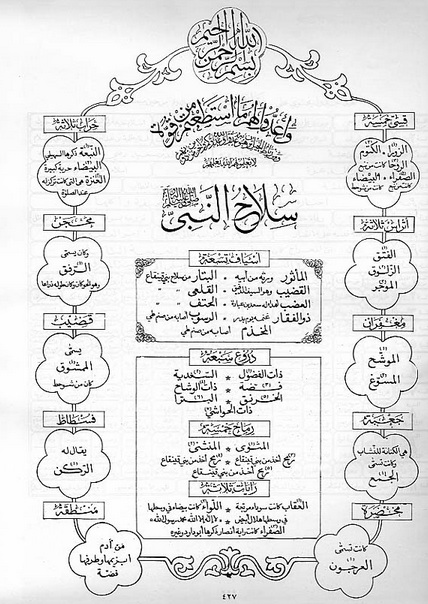
"Swords of the Prophet" chart (from Brannon Wheeler, USNA professor). Islam's founder had many blades, with different names and histories. Think this martial history has
anything to do with the lionization of violence in Islam? If not, please adduce a chart of Jesus' or Buddha's swords....
11:38 am edt
|
|
|
|
| Jamkaran Mosque near Qom, Iran (during my trip there Aug. 2008) |
|
|
|
